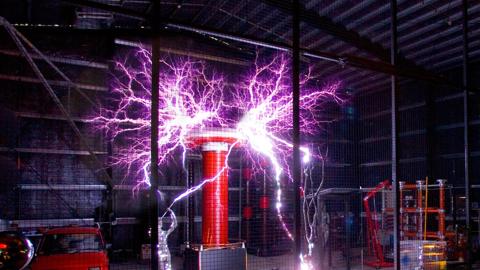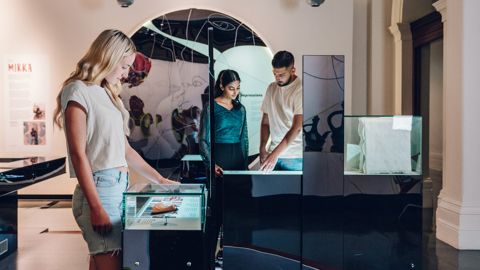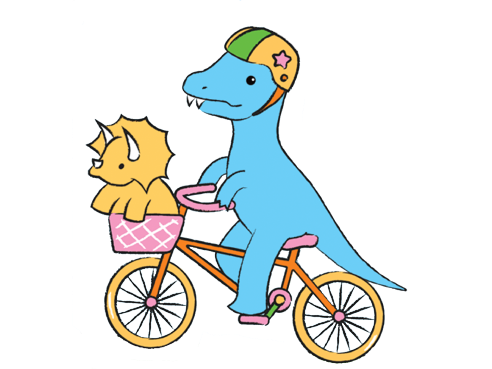Our history
From its humble beginnings in 1854, Museums Victoria has established a collection of more than 15 million items, tracing Australia’s natural, social and cultural history to help people better understand – and advocate for – the world we live in.
Museums Victoria is home to Melbourne Museum, Immigration Museum, Scienceworks and the Planetarium, the Museums Victoria Research Institute and the UNESCO World Heritage-listed Royal Exhibition Building as well as IMAX cinema.
1854 to 1900
- In 1854 the National Museum of Victoria opens in the Government Assay Office, La Trobe Street, Melbourne on Wurundjeri Woi Wurrung Country. It displays geological and natural science collections.
- The museum is transferred to more distinguished surroundings at the University of Melbourne in Parkville in 1856 and becomes formally known as the National Museum of Victoria.
- In 1863 a new building is erected at Melbourne University to house the museum. By now, the collections include agricultural and mining machinery as well as significant collections of natural history material. The Director, Professor Frederick McCoy, corresponds with scientists and collectors to develop scientific collections from Europe, Africa and the Americas.
- A separate Industrial and Technological Museum opens in the Public Library in 1870, focussing initially on public education.
- In 1899 the National Museum is relocated to the Public Library building. Melbourne's citizens are presented with the spectacle of wagons loaded with glass cases, stuffed animals and other curiosities as over 510 000 items are carted across town.
1900 to 1950
- The National Museum collections are reorganised in McCoy Hall using the most modern display techniques, ushering in a period of renewal.
- The Industrial and Technological Museum collection goes into storage until 1915 when it re-opens in Queens Hall, formerly part of the Public Library. Now four cultural bodies – the State Library, the National Museum, the National Gallery and the Industrial and Technological Museum – share the buildings on the site in Swanston St, Melbourne.
- The National Museum acquires the mounted hide of the famous racehorse Phar Lap after he dies in America in 1932. For many visitors, a look at Phar Lap in his glass case is a highlight of their trip to the museum.
- In 1939 the National Museum’s ethnographic and anthropological collections (now known as First Peoples Collections) are displayed in the eastern end of building, which had become the main entrance to the museum.
- The Industrial and Technology Museum is renamed the Museum of Applied Science (MAS) in 1945, signalling a shift in focus. While in Swanston St it takes over responsibility of the Melbourne Observatory.
1950 to 2000
- During this period the Museum of Applied Science is renamed the Institute of Applied Science (1961) and later the Science Museum (1971).
- In 1965 the H.V McKay Melbourne Planetarium opens as part of the Institute of Applied Science.
- In 1983 the National Museum and the Science Museum merge to become the Museum of Victoria.
- The museum's Aboriginal Heritage Unit and the Aboriginal Cultural Heritage Advisory committee are also established in 1983.
- In 1985 Museum Victoria establishes the Social History Department, later combining with technology collections to form the History & Technology Department.
- Scienceworks is established in 1992 in the grounds of the historic Spotswood Pumping Station in Melbourne’s inner west.
- In 1996 management/custodianship of the Royal Exhibition Building is passed from the Exhibition Trustees to Museum Victoria.
- In 1998 the Immigration Museum opens in the beautifully restored Old Customs House Building on Flinders Street.
2000 to Present
- In 2000, Melbourne Museum opens alongside the Royal Exhibition Building in Carlton Gardens.
- In 2013 the permanent First Peoples exhibition – co-curated with the Yulendj Group of Elders and community representatives from across south-eastern Australia – opens at Melbourne Museum.
- The Royal Exhibition Building becomes the first cultural property in Australia to be inscribed on the UNESCO World Heritage list in 2004.
- In 2017 as the organisation approaches its 163rd year, Lynley Crosswell is appointed as the first female CEO.
- The Museums Victoria Research Institute launches in 2022, maximising Museums Victoria’s research and collections to tackle some of the biggest and most complex challenges of our time.
List of former directors
- 1858: Frederick McCoy (National Museum of Victoria)
- 1899: Walter Baldwin Spencer (National Museum of Victoria)
- 1928: James A. Kershaw (National Museum of Victoria)
- 1931: Daniel James Mahony (National Museum of Victoria)
- 1944: Richard TM Prescott (National Museum of Victoria)
- 1951: Charles M. Focken (Museum of Applied Science)
- 1957: Charles. W. Brazenor (National Museum of Victoria)
- 1962: John McNally (National Museum of Victoria)
- 1979: Barry Wilson (National Museum of Victoria)
- 1962: R. Hindle Fowler (Institute of Applied Science)
- 1975: John Kendal (Science Museum)
- 1984: Robert Edwards (Museum of Victoria)
- 1990: Graham Morris (Museum of Victoria)
- 1998: George F. MacDonald (Museum Victoria)
- 2002: Dr J. Patrick Greene (CEO Museum Victoria)
- 2017: Lynley Croswell (CEO and Director, Museums Victoria)










